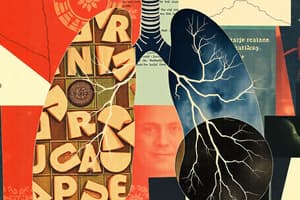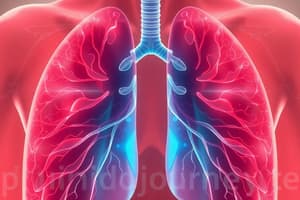Podcast
Questions and Answers
What is the primary role of the diaphragm during inspiration?
What is the primary role of the diaphragm during inspiration?
- It prevents air from escaping the lungs.
- It relaxes to pull the ribcage down.
- It increases pressure in the thoracic cavity.
- It contracts to increase space in the thoracic cavity. (correct)
How does high altitude affect the availability of oxygen?
How does high altitude affect the availability of oxygen?
- The number of oxygen molecules in a breath decreases at high altitude. (correct)
- Altitude has no effect on the oxygen content of the air.
- Humans produce more oxygen at high altitude due to increased ventilation.
- The air at high altitude is denser, making oxygen more available.
Which structure is responsible for monitoring blood pH to regulate respiration?
Which structure is responsible for monitoring blood pH to regulate respiration?
- Bronchi
- Aorta
- Medulla oblongata (correct)
- Capillary
What happens during exhalation as the diaphragm relaxes?
What happens during exhalation as the diaphragm relaxes?
Which factor does NOT influence total lung volume?
Which factor does NOT influence total lung volume?
What is the primary purpose of the alveoli in the respiratory system?
What is the primary purpose of the alveoli in the respiratory system?
Which respiratory structure is responsible for carrying air from the mouth and nose to the trachea?
Which respiratory structure is responsible for carrying air from the mouth and nose to the trachea?
What effect does a greater pressure gradient have on gas exchange?
What effect does a greater pressure gradient have on gas exchange?
What components make up the majority of oxygen transportation in the circulatory system?
What components make up the majority of oxygen transportation in the circulatory system?
What role do the mucous-producing cells in the trachea primarily serve?
What role do the mucous-producing cells in the trachea primarily serve?
During cellular respiration, carbon dioxide is converted into which substance in tissue fluid?
During cellular respiration, carbon dioxide is converted into which substance in tissue fluid?
What characteristic of the alveolar membrane facilitates effective gas diffusion?
What characteristic of the alveolar membrane facilitates effective gas diffusion?
What is the function of bronchioles in the respiratory system?
What is the function of bronchioles in the respiratory system?
Flashcards
Tidal Volume
Tidal Volume
The amount of air inhaled or exhaled during normal breathing.
VO2 Max
VO2 Max
The maximum amount of oxygen that can be used by the body during sustained, intense exercise.
Diaphragm
Diaphragm
The dome-shaped muscle that separates the chest and abdominal cavity. It contracts during inhalation, making space in the thoracic cavity, and relaxes during exhalation, decreasing the space in the thoracic cavity.
Ventilation
Ventilation
Signup and view all the flashcards
CO2 Removal
CO2 Removal
Signup and view all the flashcards
Gas Exchange
Gas Exchange
Signup and view all the flashcards
Permeable Membrane
Permeable Membrane
Signup and view all the flashcards
Alveoli
Alveoli
Signup and view all the flashcards
Partial Pressure
Partial Pressure
Signup and view all the flashcards
Gas Diffusion
Gas Diffusion
Signup and view all the flashcards
Hemoglobin
Hemoglobin
Signup and view all the flashcards
Carbon Dioxide Transport
Carbon Dioxide Transport
Signup and view all the flashcards
Study Notes
The Respiratory System
- The respiratory system has several key functions, including supplying oxygen to cells, removing carbon dioxide, providing defense against microorganisms, and controlling body fluid pH.
- Respiration is the process of getting oxygen into the body and removing carbon dioxide.
- Gas exchange happens at the cellular and lung levels. At the cellular level, diffusion causes cells to exchange oxygen and carbon dioxide.
- Ventilation deals with the respiratory structures and involves moving oxygen-rich air to the lungs and carbon dioxide-rich air away from the lungs.
- Alveoli are small sacs in the lungs surrounded by a capillary network, facilitating gas exchange. Oxygen diffuses from the alveoli into the blood, and carbon dioxide diffuses from the blood into the alveoli.
- The respiratory system in mammals has four essential components: a thin permeable membrane to allow diffusion, a large surface area for gas exchange, a good blood supply, and a breathing system for ventilation.
- Air travels from the mouth/nose through the pharynx to the trachea then branches into bronchi, which lead to bronchioles that end in alveoli.
- Blood in the lungs, low in oxygen and high in carbon dioxide is exchanged for oxygen from air and carbon dioxide is released into air. The blood then travels to the heart.
- The air we breathe is a mixture of different gases. Partial pressure is the pressure of each individual gas in a mixture. Partial pressures of gases directly affect gas exchange.
- Gases diffuse across membranes from high to low pressure until equal. The greater the pressure gradient, the higher the rate of diffusion.
- Oxygen moves from the air in the alveoli to the blood plasma due to differing partial pressures. The circulatory system transports oxygen attached to hemoglobin and dissolved in the plasma.
- Carbon dioxide, produced by cellular respiration, dissolves in tissue fluid, forming carbonic acid. This acid separates to bicarbonate and hydrogen ions. This then recombines in the blood to form water and carbon dioxide. Carbon dioxide diffuses across the alveolar membrane into the lungs.
- Ventilation (breathing) is an involuntary action controlled by the brain stem. Cells in the medulla oblongata and receptors in the carotid artery monitor blood pH, indicating the levels of carbon dioxide.
- Breathing involves the diaphragm and intercostal muscles. During inhalation, the diaphragm contracts, increasing the chest cavity volume; and the intercostal muscles pull the ribcage up and down.
- During exhalation, the diaphragm relaxes, decreasing the chest cavity volume, and the intercostal muscles bring the ribcage down.
- Lung capacity depends on sex, body type, and lifestyle. Males, non-smokers, and athletes generally have larger lung volumes. Tidal volume, is the amount of air moved in and out with normal breathing. It's relatively low, around 10% of total lung capacity. High oxygen usage rates indicate an efficient respiratory system, as it implies efficient uptake of oxygen from the surrounding air.
Altitude and Respiration
- The human respiratory system faces challenges at high altitudes.
- Above 7,000m the air pressure is low, making it hard to get adequate oxygen.
- A breath of air at high altitude contains fewer oxygen molecules than at sea level.
- The body makes physiological changes to maintain oxygen levels for the tissues, even at reduced atmospheric pressure. High altitude sickness can result if this process fails.
Studying That Suits You
Use AI to generate personalized quizzes and flashcards to suit your learning preferences.




